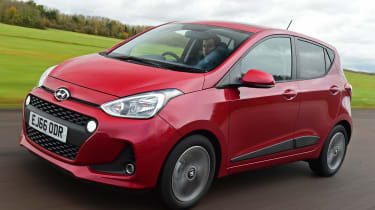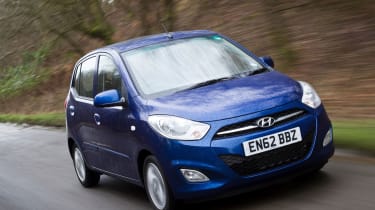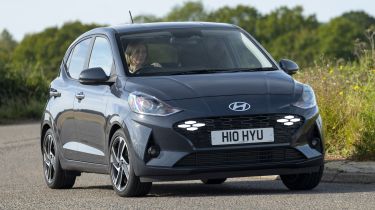Hyundai i10 review: our favourite little city car is a Tardis on wheels
The Hyundai i10 is a capable, comfortable and surprisingly practical city car, offering decent onboard tech in a simple, smart-looking package

The Hyundai i10 is a strong contender in a shrinking city car market, especially at a time when people are looking for ways to cut down on their running costs when traversing heavily congested city streets. Our 2023 City Car of the Year, Hyundai’s smallest car is more comfortable and refined than ever, while the diminutive size, tight turning circle and light steering make it an absolute doddle to drive around town.
Don’t judge the i10 solely by its dimensions though, as the cabin is surprisingly spacious and features a decent amount of onboard technology, including wireless smartphone connectivity and several safety features. The regular i10’s petrol engines are very frugal too, or if you want something with a little more attitude, then the souped-up i10 N Line has that covered.
Our choice: Hyundai i10 1.2 Premium
About the Hyundai i10
The city car is something of a dying breed these days, as the likes of the Toyota Aygo, Citroen C1, Peugeot 108, Skoda Citigo, Volkswagen up! and Ford Ka have all kicked the bucket. Thankfully some brands haven’t given up on the segment yet, and the Hyundai i10 is very much alive and well, having received a facelift and boost in equipment levels in 2023.
More reviews
Car group tests
- Hyundai i10 vs Kia Picanto: 2022 twin test review
- Toyota Aygo X vs Hyundai i10 vs Fiat 500: 2022 group test review
- Hyundai i10 vs Toyota Aygo vs Kia Picanto
In-depth reviews
Road tests
- New Hyundai i10 N Line 2024 review: souped-up city car proves size doesn’t matter
- New Hyundai i10 N Line 2020 review
- New Hyundai i10 2020 review
Used car tests
Although the city car competition has reduced in numbers, the i10 is not yet in a class of its own, so it must be able to prove itself against the Toyota Aygo X, Suzuki Ignis and its own sister car, the Kia Picanto. The Dacia Sandero and Citroen C3 superminis also pose a threat to the i10 as they’re offered at similar prices with more space.
The i10 range features three standard petrol engine options, with no hybrid, diesel or fully electric versions available. A 1.0-litre, three-cylinder unit with 66bhp is the entry point to i10 ownership, followed by a 1.2-litre four-cylinder engine, producing 83bhp. The top-of-the-range 1.0 turbo three-pot petrol delivers 99bhp but can only be found in the sporty N Line version. All cars feature a five-speed manual gearbox as standard. The 66bhp and 83bhp engines are available with an automated manual transmission, but we would not recommend it for reasons we’ll explain later.
There are just three trim levels to choose from: Advance, Premium and N Line. Standard kit includes 15-inch alloy wheels, an eight-inch touchscreen with wireless Apple CarPlay and Android Auto smartphone connectivity, Bluetooth, a multi-function leather-wrapped steering wheel, a 4.2-inch display in the instrument panel, keyless entry, rear parking sensors and a reversing camera. Meanwhile, safety features include collision avoidance assist, pedestrian detection, speed limit assist, lane keep and follow assist.
Higher-spec models get a wireless charging pad, heated front seats and steering wheel, 16-inch rims, LED interior lighting and electric folding door mirrors. Premium trim models also feature tartan upholstery and purple stitching, while N Line cars come with an aggressive styling kit, lots of red accents, brushed metal pedals and bespoke seats.
With a starting price of over £15,000, the Hyundai i10 is still one of the cheapest new cars you can buy in the UK right now and undercuts its Aygo X by several hundred pounds. Unfortunately, it can’t beat the sub-£14,000 price tag of the most basic Dacia Sandero.
Used and nearly new
The original i10 of 2008 was a big success for Hyundai – especially in the UK, which accounted for more than a third of the 110,000 sales the city car notched up in Europe in the six years it was available. Designed to replace the brand’s underwhelming Amica and Getz, the i10 served up a surprising amount of sophistication for such a small car, not to mention loads of standard kit. It was also backed by Hyundai’s five-year and unlimited-mileage warranty.
The second-generation car had big boots to fill when it arrived in 2014, but impressed immediately with its handsome looks and grown-up driving dynamics. The Mk3 that arrived in 2019 built on these strengths with even sharper style, a roomier interior and all the latest tech, and was then updated in 2023 to add more safety features and a few bits of extra kit.
Hyundai i10 history

Hyundai i10 Mk3: 2019 to present
One of our favourite small cars, the third-generation i10 melds sophisticated style with cutting-edge tech and infotainment. It’s also good to drive, with composed handling and the sort of refinement you’d expect from a bigger car. Yet its smooth, small-capacity engines also blend eager performance with penny-pinching running costs.

Hyundai i10 Mk2: 2014-2019
Faced with brilliant rivals such as the VW up!, Hyundai's engineers aimed to deliver a small car that was even more grown-up to drive and sit in. Overall, they hit the bullseye, because while the i10 wasn’t as much fun to drive as some, it set the standard for comfort, refinement and practicality. You can read our full Hyundai Mk2 used buyer’s guide here.

Hyundai i10 Mk1: 2008-2014
Replacing the lacklustre Getz, the i10 was the city car that proved Hyundai meant business. Slightly bland looks aside, it was easy to drive, surprisingly spacious and great value for money. In top-of-the-range form, it even offered enough kit to make an executive saloon driver green with envy. It was a big hit following the UK’s 2009 Scrappage Scheme, with thousands of drivers trading up to the Hyundai from their old bangers.
For an alternative review of the Hyundai i10, visit our sister site carbuyer.co.uk...









